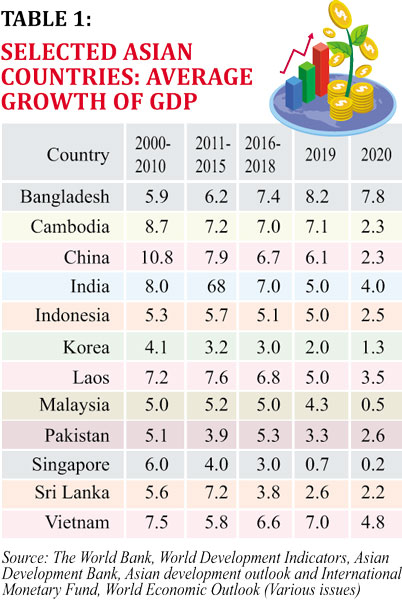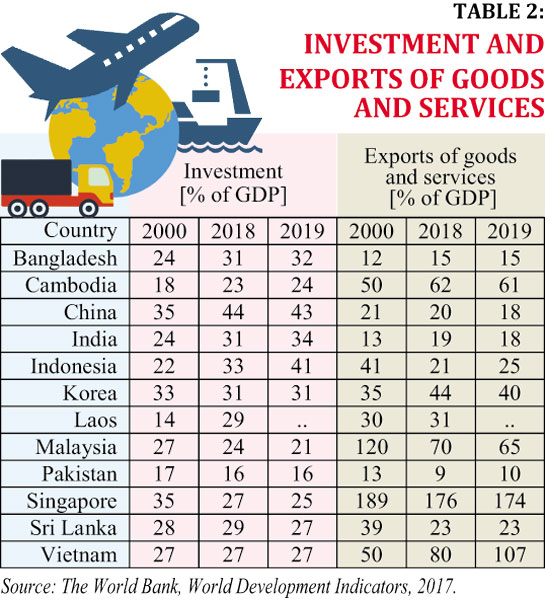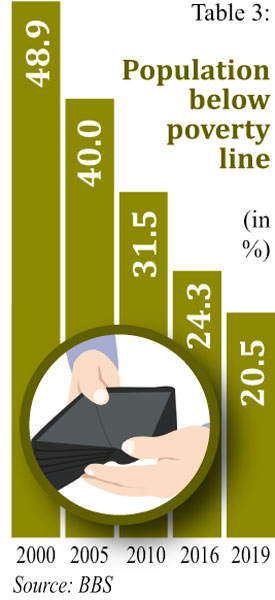 Practically all countries in the world have suffered major setbacks in their macroeconomic performance due to disruptions of economic activities caused by Covid-19. Bangladesh is no exception. This article is not about the impact of Covid-19 per se, though references will be made to it as needed. The objective is to give a summary picture of Bangladesh's achievements in selected dimensions of the macro economy and the challenges the country has to overcome in order to improve its performance.
Practically all countries in the world have suffered major setbacks in their macroeconomic performance due to disruptions of economic activities caused by Covid-19. Bangladesh is no exception. This article is not about the impact of Covid-19 per se, though references will be made to it as needed. The objective is to give a summary picture of Bangladesh's achievements in selected dimensions of the macro economy and the challenges the country has to overcome in order to improve its performance.
Macro economy is a multidimensional concept encompassing diverse issues such as growth of gross domestic product (GDP), employment, incidence of poverty, distribution of income among various segments of population, development of human resources, price stability etc. The focus in this article is on two critical issues: Growth and poverty alleviation.
 GROWTH PERFORMANCE: GDP growth performance of Bangladesh has been undoubtedly stellar and improved consistently overtime. Growth averaged 3.8 per cent during 1980-1985, 5.9 per cent during 2000-2010, 6.2 per cent during 2011-2015, 7.4 per cent during 2016-2018 periods. Among a sample of 12 countries including Bangladesh, six countries achieved higher growth than Bangladesh during 2000-2010, five countries during 2011-2015 and none during 2016-2020.
GROWTH PERFORMANCE: GDP growth performance of Bangladesh has been undoubtedly stellar and improved consistently overtime. Growth averaged 3.8 per cent during 1980-1985, 5.9 per cent during 2000-2010, 6.2 per cent during 2011-2015, 7.4 per cent during 2016-2018 periods. Among a sample of 12 countries including Bangladesh, six countries achieved higher growth than Bangladesh during 2000-2010, five countries during 2011-2015 and none during 2016-2020.
There are a number of reasons why countries, in particular developing ones, seek to accelerate growth. It is likely to create more employment opportunities, including for the poor and unskilled workers.
Apart from the direct employment, the poor benefit, at least partially from the trickle down effects of growth. Growth generates more resources for the government that can be deployed for provision of extensive public services such as preventive and primary healthcare, education, infrastructure (roads, railways, water transportation), energy etc.; which benefit most of a country's population, including the poor. With greater availability of resources, governments are in a stronger position to expand the coverage of programmes specially targeted to redress the plight of the poor.
Growth is a headline number that attracts the attention of the world. It generally encourages foreign direct investment (FDI) which helps meet foreign exchange gap. Foreign investors, under appropriate circumstances, contribute to technology transfer, enhancement of skill of workers and management expertise through demonstration effect.
DETERMINANTS AND CHALLENGES: Many factors contribute to a country's growth. The focus in this article is on investment and exports. The rationale is that these two factors are strongly correlated with growth performance of most developing countries.
INVESTMENT: In Bangladesh investment grew positively albeit at a rather slow rate


However, a matter of concern is that private investment as proportion of GDP remained stagnant between 22 per cent-23 per cent over almost a decade (FY2011-FY 2019). In FY 2020, according to official estimate, the proportion fell drastically to 12.7 per cent as a result of the unfavourable situation created by Covid-19.
With or without Covid-19 Bangladesh has to confront a number of challenges to spur investment. These include deficiencies in physical infrastructure, energy, political uncertainty, poor quality of education leading to poor quality of human resources, and low scores in Governance, and Ease of Doing Business (EDB) indicators (World Bank has decided to discontinue the publication of EDB).
Besides, the role of the financial sector in financing investment leaves a lot to be desired. During FY20 credit to the private sector grew by only 8.6 per cent, far below the target set by Bangladesh Bank. As regards public investment, delay in implementation, cost overruns, poor quality of works, hasty utilisation of allocation in the second half of the fiscal year, approval of too many projects without due consideration of priorities leading to insufficient allocations undermine its potential contribution to growth acceleration.
As far as governance (which is based on Rule of Law, Control of Corruption, Government Effectiveness, Absence of violence and Regulatory Quality) in concerned, the achievement of most Asian countries is better than that of Bangladesh.
With respect to EDB also Bangladesh gives a rather dismal picture despite some improvement in recent times. This indicator is based on 11 sub indicators: Starting a business, Dealing with construction permits, Getting electricity, Registering property, Getting credit, Protecting minority shareholder interest, Trading across borders, Enforcing contracts, resolving insolvencies and Labour market regulations.
In 2017 the rank of Bangladesh was 177 implying that 176 countries performed better. Various agencies of the Government are trying to effect improvement in consequence of which there has been some upward movement. According to the latest available information the rank of Bangladesh stood at 168.
EXPORTS: Bangladesh has been doing reasonably well in exports which increased from 4.9 per cent of GDP in 1985 to 15 per cent in 2019 (table2). However, its performance pales in comparison with other Asian countries. In 2019 only Pakistan had a lower proportion export in GDP. This sector suffered jolt due to Covid-19. Some signs of recovery have emerged recently. Overall exports registered a negative growth of -0.31 per cent during July-August of FY22.
An important challenge in the area of exports is to reduce overwhelming dependence on garments. Other challenges are raising the quality of garment products so as to be able to fetch higher unit price, diversification of the basket of export goods and diversification of destination markets. In this context it is worth mentioning that garment exports to non-traditional markets have suffered decline in absolute value in recent times. The growth has come mainly from the traditional markets: European Union, United States and Canada. However, there are worries that the growth may not be sustained due to the second wave of Covid-19.
REMITTANCE: Macroeconomic situation of Bangladesh has benefited considerably from the remittances by our workers employed abroad. These have fluctuated on year-to-year basis while maintaining secular upward trend. After suffering a negative growth of 14.5 per cent in FY17, it rose by 17.3 per cent in FY18, 10.87 per cent in FY 20 and by as much as 49.95 per cent during July-August of FY 21. However, this high growth is unlikely to be sustained. During July-August of FY 22, remittance fell by 19.3 per cent.
Remittances contribute to economic growth by sustaining domestic demand, particularly from many poor households. Besides, these help meet foreign exchange gap and ensure exchange rate stability and thereby smooth conduct of foreign trade. The challenges in this context relate to diversification of destination markets, solving problems faced by workers in the existing markets and enhancement of skills of migrant workers.
POVERTY ALLEVIATION: For a country like Bangladesh with a large number of people below poverty line, poverty alleviation is unquestionably an important macroeconomic objective. This is not merely socially desirable, but also an economic necessity. The reason is that poor people cannot afford to invest in health, education, training etc. and therefore overall productivity of the country suffers.
Here again, Bangladesh made substantial progress over the years but the progress is undesirably slowing down. The annual average rate of reduction of the proportion of people below poverty line was 1.8 per cent between 2000-2005, 1.7 per cent between 2005-2010, 1.2 per cent between 2010-2016 and about the same between 2016-2019
In part this eventuality can be attributed to rising inequality of income distribution. In order to bring about a change in this scenario, it is essential to increase budget allocation for social safety net, health and education and ensure effective use so that desired benefits can be harnessed. This has assumed high priority because Covid-19 has dealt a severe blow to household income. It is reported household income on average fell by 20 per cent between March and August 2020. There are reports that the proportion of people below poverty line may have increased to 30 per cent.
A FEW CONCLUDING COMMENTS: This article has focused on only two dimensions of Bangladesh's macro economy: growth and poverty alleviation.
• Growth and poverty alleviation can be complementary; growth can potentially reduce poverty and poverty alleviation can accelerate growth.
• In Bangladesh growth acceleration has been accompanied by falling rate of poverty reduction. The underlying causes should be identified and appropriate corrective actions should be undertaken.
• The Government announced substantial stimulus packages, but there are many complaints about improper distribution. These should be addressed.
• Public expenditure on health, education and social safety net should be further increased while ensuring effective use.
• More determined efforts are needed to improve substantially Governance and Ease of Doing Business.
• Basket of export goods as well as destination market should be diversified and higher quality should be ensured.
• The challenges relating to remittances should be expeditiously addressed
• Institutions of delivery of various incentives and stimulus packages to deal with the unsavoury impact of Covid-19 should be more efficient and the bureaucracy has to be made accountable. So far, a significant proportion of stimulus packages for cottage, micro, small and medium enterprises as well as for the farm sector has not been disbursed.
• The recent news about Bangladesh graduating from the category of LDCs is definitely an encouraging one. But the challenges are likely to arise from loss of duty free and quota free access of exports, more rigorous terms of external assistance and the need for compliance with intellectual property regulations.
Dr Mirza Azizul Islam is a former Caretaker Government adviser for Ministries of Finance and Planning and presently a professor at the Business School, BRAC University.
maislam@bracu.ac.bd
© 2025 - All Rights with The Financial Express
